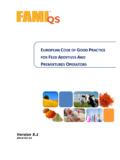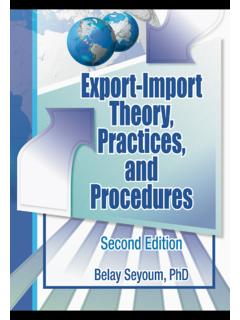Transcription of European Code of Practice for Feed Additive and Premixture ...
1 FAMI QS Code of Practice European Code of Practice for feed Additive and Premixture Operators 1 Introduction This European Code of Practice for Animal feed Additive and Premixture Operators ( Code ) is in line with the Regulation of the European Parliament and the Council laying down requirements for feed hygiene, (183/2005/EC), in particular articles 20 to 22 which encourage the development of guides to good Practice on hygiene and the application of HACCP principles. Implementation of the Code aims to encourage measures to be put in place to ensure the safety and quality of feed additives and premixtures; the operation of businesses in accordance with European feed hygiene requirements, and improved traceability.
2 The Code applies equally to import from third countries of feed additives and premixtures. In order to align the Code with current animal feed legislation and various activities on national, industrial and/or association levels, it takes into account the principles of feed and food safety as well as HACCP principles that are set out in various international documents further down and EC legislation, in particular: The European Commission s White Paper on Food Safety (COM (1999) 719 final) Regulation (EC) No 183/2005 of the European Parliament and of the Council of 12 January 2005 laying down requirements for feed hygiene (and repealing Council Directive 95/69/EEC and Commission Directive 98/51/EEC (apart from article 6 on Interim measures), laying down conditions and arrangements for approving and registering establishments and intermediaries in the animal feed sector).
3 (Regulation (EC) No 183/2005) http://eur Regulation (EC) No 1831/2003 of the European Parliament and of the Council on additives for use in animal nutrition. (Regulation (EC) No 1831/2003). lex/pri/en/oj/dat/2003/l_268 Regulation (EC) No 178/2002 of the European Parliament and of the Council of 28 January 2002 laying down the general principles and requirements of food law, establishing the European Food Safety Authority. (Regulation (EC) No 178/2002). lex/pri/en/oj/dat/2002/l_031 Regulation (EC) No 882/2004 of the European Parliament and of the Council of 29 April 2004 on official controls performed to ensure the verification of compliance with feed and food law, animal health and animal welfare rules.
4 (Regulation (EC) No 882/2004) http://eur documents: The relevant Codes of Practice of the Codex Alimentarius. 5, 1 April 2009 Page 1/39 FAMI QS Code of Practice The principles of HACCP, re. Codex Alimentarius, General principles of Food Hygiene, (CAC/RCP 1 1969, Rev. 4 2003 Amd. (1999), Annex on Hazard Analysis and Critical Control Point (HACCP) System and Guidelines for its Application) Management systems developed by associations in different Member States, for example, other Codes of Practice and Quality Assurance Schemes : Code of Practice (FEFAC, EU) FEMAS (AIC, UK) (OVOCOM, B) + (PDV, Nl) +S (DVT, D).
5 The combination of the above principles provides guidance for feed Additive and Premixture operators in implementing the measures necessary to ensure feed safety in European and international manufacturing and trade. In order to facilitate implementation of the Code, the structure of ISO 9001:2000, Quality Management Systems, is used. In the exceptional case where a direct or indirect risk to human or animal health is related to a product manufactured and marketed under the Code, the information and recall procedures (including the rapid alert system) defined in Regulation (EC) No 178/2002 shall apply.
6 The text of the Code is designed to set out general requirements and to be used by operators as a tool to develop their own procedures. A compilation of guidance is provided as annex to the Code. This covers topics of special importance. While the requirements of the Code are mandatory for every operator , the Guidance provides information on how to deal with specific issues in a more detailed and practical way and may serve as further supporting information to the Code. If the operator decides to follow the procedures described in the Guidance, this will become a part of its Safety System.
7 In case that, for good reasons, different procedures are used, the operator must be able to provide evidence upon request that he is complying with the requirements of the Code as well. Both the Code and Guidance will be submitted to periodical review in line with emerging/new relevant technological, scientific and legislative developments or statutory modification in the sector. Note: FAMI QS Code of Practice is a public document and its contents can be freely followed by any feed Additive or Premixture operator . Running side by side with the Code FAMI QS Asbl has developed a parallel and independent certification system that is described in the Rules for Certification documents.
8 Participation in the FAMI QS auditable system is based on voluntary commitment. Please, consult the FAMI QS web page to have access to these documents and learn more about how to ensure compliance with this Code of Practice . Version 5, 1 April 2009 Page 2/39 FAMI QS Code of Practice TABLE OF CONTENTS 1 2 3 Terms and 4 Management System (MS) ..10 General 10 Management 10 General documentation 10 5 Management Management 13 Quality and safety 13 Responsibility, authority and 13 Management 14 Management 14 6 Resource Provision of 16 Human 16 Competence, awareness and Personal 17 Basic Requirements for facilities.
9 Production areas and Facilities and production Maintenance and control of monitoring and measuring 18 19 Pest 20 Waste 21 7 Product Product 22 Determination of requirements related to the Compliance of the product to the Customer HACCP 23 Design and 24 Development of new products and Version 5, 1 April 2009 Page 3/39 FAMI QS Code of Practice Change Handling of incoming 25 Sourcing of incoming Verification of incoming Production of finished 27 Quality control and Verification of processes for Identification and Preservation of 30 General Transport of packaged Transport of bulk 8 System General 33 Internal 33 9 Control of non conforming General 35 Complaint handling 36 37 Crisis 38 10 Statistical Version 5.
10 1 April 2009 Page 4/39 FAMI QS Code of Practice 2 Scope The aim of this European Code of Practice is to ensure safety of feed additives and premixtures by: minimizing the risk of adulterated feed additives and premixtures entering the feed /food chain; enabling an operator to implement the objectives of the feed hygiene Regulation (Regulation (EC) No 183/2005); and providing measures to ensure that other applicable regulatory feed safety requirements are met. feed is considered unsafe for its intended use if it is likely to pose a risk to (has adverse effect on) human or animal health, or if the food derived from food producing animals fed the feed is unsafe for human consumption.








